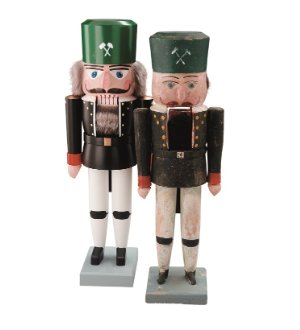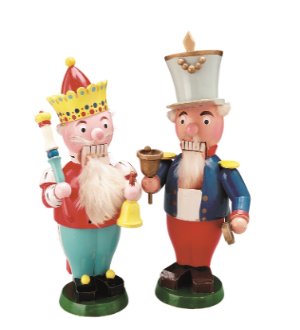




The Americans love the wooden toy soldier nutcracker so often associated
with Christmas, and many have a collection of their own as large or
larger than the displays seen in department stores. This
type of nutcracker made an appearance around 1800 in Germany, and by
1872 Wilhelm Füchtner had started a nutcracker production, making many
of one design with his lathe. He was named ‘The Father of
the Nutcrackers’ because his body design has been continually used by
most of the German makers. The Füchtner family, now in its
6th generation, continues to make nutcrackers in
the same workshop at Seiffen in the Erzgebirge, and every collector of
German nutcrackers should have at least one of these “original”
nutcrackers.
The family of Christian Ulbricht, now including members of its 4th generation,
is the most prolific of nutcracker makers today. With factories humming
both in Bavaria and the Erzgebirge, they strive to meet the great demand
for their products. The quality of their designs is
superb, and their natural wood finishes win hearty accolades from
collectors. From the smallest size to the large Premier
size, there is no better choice than an Ulbricht nutcracker.
Christian Steinbach started his factory soon after WWII and reigned as
‘King of the Nutcrackers’ until his death in 2007. Unlike the Ergzebirge makers
who basically made military type figures, he introduced many different
figures with rich cloth costumes such as Sir Galahad, Thief of Bagdad,
and The Twelve Days of Christmas. He also made signing trips to the US
which endeared him to his collectors. His stylish and
often flamboyant designs still demand a huge price on the secondary
market, and you can often find items with a Christian Steinbach
signature that will increase the value. Although the
Steinbach factory in the Erzgebirge still produces nutcrackers , it is
now under new ownership and no member of the family is involved in its
production.
Other larger Erzgebirge factories such as Richard Glasser, KWO
(Kunstgewerbe Werkstatten Olbernau), Legler, and Seiffener Volkskunst
produce quality nutcrackers, each with its own variance on the
traditional body style. Smaller workshops such as Gunter
Ulbricht, Mueller, Zeidler Holkunst and Olaf Kolbe provide a variety of
nutcrackers for the collector.
If you are interested in older turned Erzgebirge nutcrackers, you may
run across others in addition to the Füchtner family who were producing
nutcrackers from the beginning of the 20th century. You
can sometimes find the names of Julius Glässer and Richard Langer in
antique shops or at estate sales. Remember the early
nutcrackers were not only used to crack nuts but were also toys for
children. so, it is difficult to find one that does not show damage from
____use.
Between 1949 and 1990, the Soviet Union was in control of the
Erzgebirge, and exported products were marked with ‘Expertic’ or ‘GDR’
(German Democratic Republic). ‘Vero’ was the brand name
used for nutcrackers produced in the Seiffen factory originally owned by
the Ulbricht family when it was taken over by the Soviet Union.
Some collectors buy only those of a single maker while others gather
from many makers. Some collect only soldiers, or kings, or
sports figures, or Santas, or nutcrackers that represent the activities
of the family. Some buy only small sizes to fit certain
shelves, while others like gigantic figures to make a
statement. Some only put their nutcrackers out at Christmas time while
others collect those that fit into the yearly holidays and festivals.
When collecting nutcrackers, Remember, it is your collection so you should collect those you truly like, those that bring you keen pleasure and delight.
Monday - Saturday 11-5pm
Sunday - 11-4:30pm
We suggest visitors arrive at least 30 minutes before closing.
"To foster and encourage the interest of the general public of the importance of nuts in the diets of humans throughout history and in the evolution of the nutcracker. No other tool or collectible has shown such a wide diversity of material and design as the implements used to crack the hard shell of a nut".